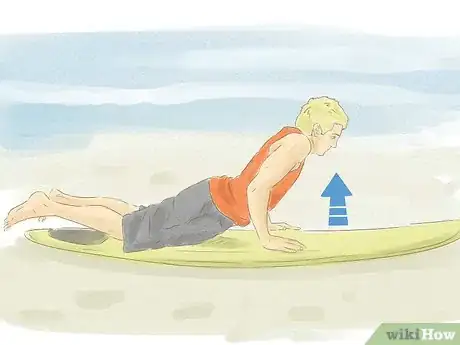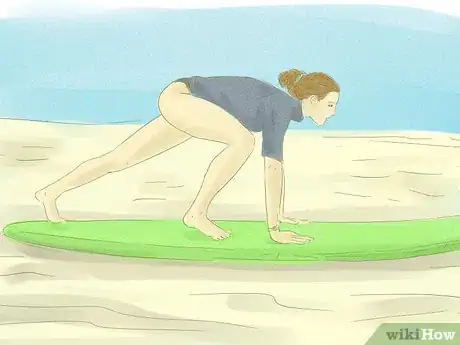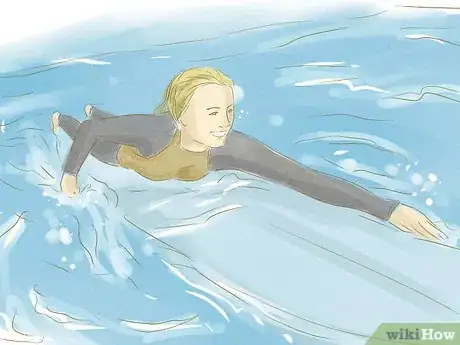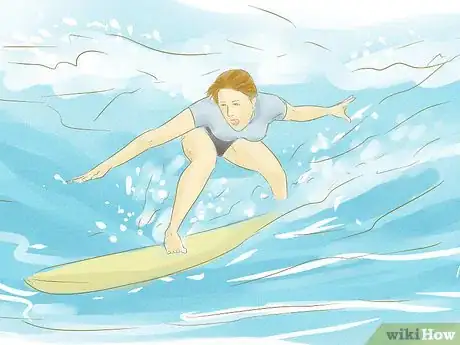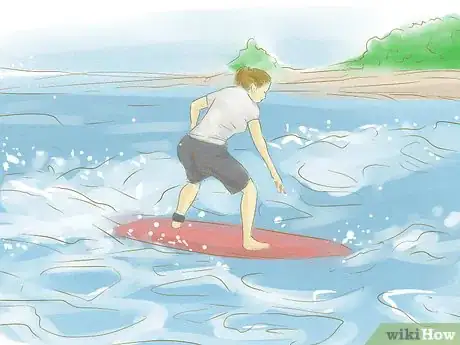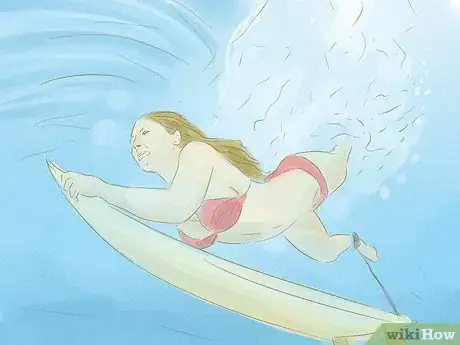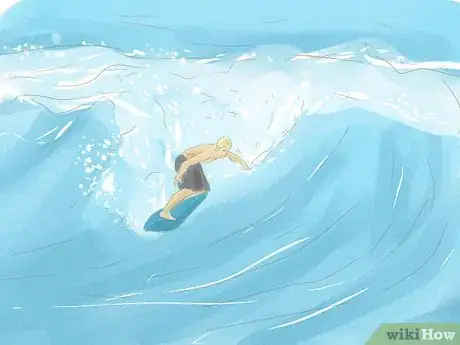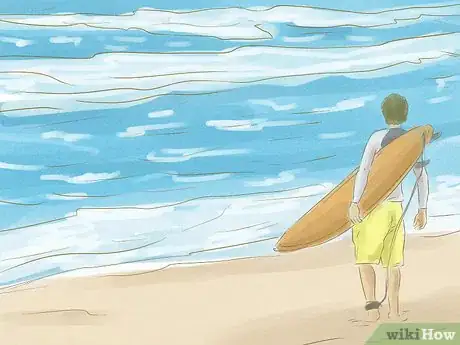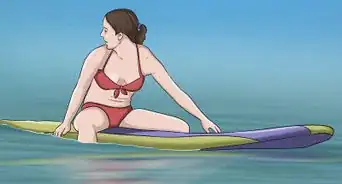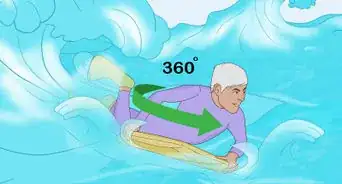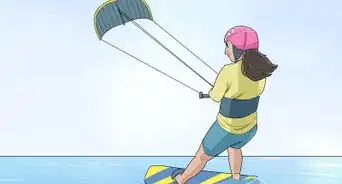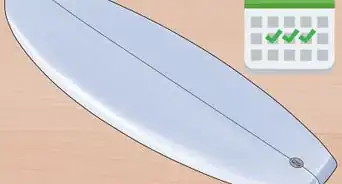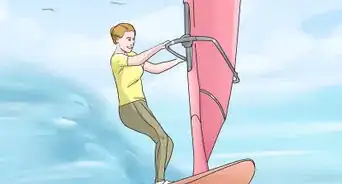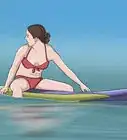This article was co-authored by Jack Herrick, a trusted member of wikiHow's volunteer community. Jack Herrick has a passion for surfing, which has been a love since the early 2000's. He has surfed in Hawaii, Costa Rica, and the Northern California coast.
wikiHow marks an article as reader-approved once it receives enough positive feedback. In this case, 90% of readers who voted found the article helpful, earning it our reader-approved status.
This article has been viewed 169,155 times.
Learn more...
For a surfer, the feeling of standing and surfing a wave can only be described as the "ultimate feeling." Whether you are a beginner or experienced surfer the feeling is achieved by standing on the surfboard and using correct techniques to benefit from the natural power of the ocean.
Steps
Practicing the Correct Technique
-
1Get in position on land. Before you get into the water, you need to practice your technique. Here's what to do:
- To start, lay on the board with your toes touching the tail. Make sure your hands are in the right position – don't grip the board at its sides, but instead place them flat on the board very close to your chest.
- Lift up your chest using your hands. Remember to not look down – instead look straight up and don't move your head. Looking down or behind you can make you scared or unbalanced.
-
2Practice your take off. This is when you go from laying on your stomach with your hands on the ground by your chest and elbows bent to pushing up your chest with your hands then popping or jumping into standing position. Standing position on a surfboard is with bent knees, feet wide apart, and feet and body facing either the left or right (your good side or whatever feels comfortable) while looking forward.[1]
- You have to be good at doing quick take offs on the ground before moving to the water. When you've paddled into the wave and you feel it take you and the wave angles you down, that's when you have to quickly pop up to standing, using this technique.
- Don't lean forward because you may flip your board over (scary!). A low center of gravity helps that, so bend your knees.
Advertisement -
3Alternatively, use the 3-step method. This is where you kneel in between laying down on the board and standing up. Move up your left foot and place it where your knee used to be. Then bring your other leg up (your right one) to fully stand up. Place them about shoulder length apart and in the center of the board, in a sort of lunging position and twist with your hips until you are standing.
- Put out your hands like they do in the movies – it actually works for the balance.
- Once you have caught the wave, go from paddling position to a kneeling position by bringing your knees forward in one swift movement. Do not lean back while kneeling or you will fall off your board.
Going into the Water
-
1For beginners, use a foam surfboard on the right beach. A foam surfboard will be lightweight and easy to use. Make sure you're on a beach with waves that break far out instead of waves that break right on the beach – these waves are ideal for surfing.
- Check the weather, too. Bad weather could lead to an unfortunate accident. And as for the shoreline, stick for something that isn't too rocky. That's a recipe for disaster.
EXPERT TIPJack Herrick has a passion for surfing, which has been a love since the early 2000's. He has surfed in Hawaii, Costa Rica, and the Northern California coast.Experienced Surfer
 Jack Herrick
Jack Herrick
Experienced SurferJack Herrick, founder of wikiHow, advises: “The most important thing for beginners is to find an area that is friendly. You don't want to end up at a beach with a lot of competition for the surf break. And if you can, try to start out surfing somewhere warm. You want to avoid getting pummeled around in cold water, which sometimes happens when you're starting out.”
-
2Take your board and get in the water. If you have a leash, put it around your ankle. This will prevent you from losing your board. Once your board is in the water, lay on your stomach and start paddling – one arm and then the other. Paddle over the forming waves, going far back to where the waves are just mere currents.
- When you're ready, turn your board around and start paddling forward. You will probably catch a wave. When you do, put your hands on the board and lift your body up onto your feet. Start off crouching low and then slowly stand up with your arms out for balance. Do this until you get to shore.
-
3When a wave comes, paddle to catch up with it. You want to be there and ready when it begins to roll over but before it actually does. As you come over it's edge, raise your torso up with your arms on either side of the board. Then, if you are a righty, put your left foot in front of your body and use it to lift up your right foot. Then ride the wave left or right as it crashes behind you.
- For a while, you're going to be snapped off your surfboard by the water. Don't get discouraged; each time you go out into the water, you're perfecting just what it is you have to do. It's a normal part of the learning curve.
EXPERT TIPJack Herrick has a passion for surfing, which has been a love since the early 2000's. He has surfed in Hawaii, Costa Rica, and the Northern California coast.Experienced Surfer
 Jack Herrick
Jack Herrick
Experienced SurferTake note of surfer etiquette while you’re trying to catch waves. Jack Herrick, founder of wikiHow, advises: "There’s one simple rule of thumb. The person who’s standing first, closest to the curl, owns the wave. If you're finding it hard to tell, someone who’s getting up before you likely owns the wave.”
-
4Ride the wave. Combine the following factors to form a solid foundation. This will enable you to stay stable and get the maximum ride out of the wave.
- Place your front foot on the chest line and in a direction that goes across the deck, your back foot is placed so your legs are slightly wider than shoulder width.
- Keep your knees bent at all times. This will lower your center of gravity and assist you in keeping your balance on the surfboard.
- Push your hips forward to transfer your weight onto the front leg. Your back leg should dip in slightly to make your stance more comfortable and give you more style.
- Keep your arms up, especially your front arm. Out stretch your front arm so you are reaching for the nose of the surfboard, your back arm should also be outstretched but don't worry too much about it.
- Position your head up and looking forward. If your front arm is up, your head should be looking straight along it. Keeping your head up has been mentioned through a lot of my articles and is a major contributor in you achieving the best result from your surfing.
-
5Keep your momentum going. Once catching a wave, your hands should be at about half of the board's length and your head should be about 3–4 feet (0.9–1.2 m) away from the front of the board. Keep your arms up in "surfer's position" to establish directionality as you ride the wave and apply pressure or extra needed weight onto your front foot in accordance with your arms in order to steer.
- Stand with your dominant foot on the middle of the board and your back foot about 2–3 feet (0.6–0.9 m) away from the back of the board.
Becoming a Pro
-
1Catch a few broken waves closer to shore. You wouldn't bet on a baby to run a marathon, so don't insert yourself in the line up right away if you don't have to. Paddle out to sea and catch a broken wave in shallower, white water nearer to the shore.
- Take a moment to master sitting on your board, too. While you're doing this, make sure you're always facing the waves – never turn your back on something that could seriously injure you. Anytime you're waiting for a wave, keep facing the horizon.
-
2Master the art of duck diving. This is a technique that allows you to go under breaking waves instead of getting pummeled time and time again each time you go out for a surf. There is a different technique for using a short or long board:[2]
- For short boards, gain speed as you approach the wave. Around 2 feet (0.6 m) before making contact with the water, grab the edges of the surfboard between the nose and middle of your board. Push you weight onto your hands until the nose goes under. Put your head down and your body will follow. Once your body is below the surface, take your front leg and bend it down, using that knee to push the tail under the wave. This momentum will put you in the water for only a second or two.
- For long boards, push up your chest and let the wave pass under your body and over the board. The "shoot and scoot" method is where you sit on the back of your board and put the tail of it into the water, grabbing the edges of the board at the center so it raises above the wave.
-
3Start angling your board. You don't just want to ride a wave to shore, you want to ride it parallel to shore for as long as possible. You want the longest possible ride with the most possible speed. Here's how:
- Bend your knees to keep a low center of gravity. Lightly lean your weight in the direction you want to go, toward the face of the wave. This will push the rail of your board into the water and elicit a keel effect that cuts into the water, directing your board.
- On a long board, use the rear section of your board to turn. If you lean too far forward, the rail will dig and you'll be off in no time.
-
4Study the waves. It'll take some time, but eventually you be able to predict wave behavior. In addition to being out there and in it, just observe the waves and how they act. Eventually you'll be able to spot the wave that's just right, the one that's in the Goldilocks zone. You'll be able to tell which waves are mushy and which are hollow, determining your course of action.
Community Q&A
-
QuestionCan I use my arms when surf?
 Community AnswerYes, insofar as you will use your arms to paddle out and to maintain balance on your board.
Community AnswerYes, insofar as you will use your arms to paddle out and to maintain balance on your board.
References
About This Article
To stand up on a surf board, start by laying on your board in the water and paddling to catch up with a wave as it approaches. Then, as you come over the edge of the wave, put your hands on both sides of the board and lift your body into a low crouch. When you’re balanced in that position, move into a standing position with your feet perpendicular to the board, and your legs slightly wider apart than your shoulders. Make sure you keep your knees bent and your weight on your front leg, and stretch your arms out across the length of the board for balance. For tips on how to practice the right technique on land before you try it in the water, scroll down!
